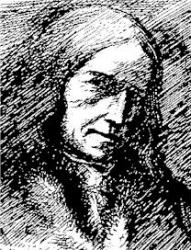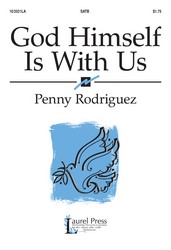- |
User Links
God Himself Is With Us

God Himself is with us, Let us now adore Him
Translator: John Miller; Translator: Frederick W. Foster; Author: Gerhardt Tersteegen (1729)Tune: ARNSBERG
Published in 112 hymnals
Printable scores: PDF, MusicXMLPlayable presentation: Lyrics only, lyrics + musicAudio files: MIDI, Recording
Representative Text
1. God himself is present;
Let us now adore him
And with awe appear before him.
God is in his temple;
All within keep silence;
Humbly kneel in deepest rev'rence.
He alone
On his throne
Is our God and Savior;
Praise his name forever!
2. God himself is present;
Hear the harps resounding;
See the hosts the throne surrounding,
Holy, holy, holy!
Hear the hymn ascending,
Songs of saints and angels blending.
Bow your ear
To us here;
Hear, O Christ, the praises
That your Church now raises.
3. Fount of ev'ry blessing,
Purify my spirit,
Trusting only in your merit.
Like the holy angels,
Worshiping before you,
May I ceaselessly adore you.
Let your will
Ever still
Rule your Church terrestrial
As the hosts celestial.
Source: Hymns and Devotions for Daily Worship #361
Translator: John Miller
Miller, John (sometimes given as Müller, or Muller), was a Moravian minister at various places in England and Ireland from 1768; finally at Cootehill, Co. Cavan, from 1805 to 1810. His original hymns and translations were contributed to the Moravian Hymn Book, 1789. --John Julian, Dictionary of Hymnology, New Supplement (1907) Go to person page >Translator: Frederick W. Foster
Foster, Frederick William, second son. of William Foster, was born at Bradford, Aug. 1, 1760, and educated at Fulneck, near Leeds, and at Barby in Prussian Saxony. Entering the Moravian Ministry he held several appointments until 1818, when he was consecrated a Bishop of the Moravian Church. He died at Ockbrook, near Derby, April 12, 1835. He compiled the Moravian Hymn Book of 1801, the Supplement of 1808, and the revised edition of 1826. His translations from the German, and his original hymns appeared in that collection. Two of his original hymns are in the Irish Church Hymnal, 1873; (1) "Lord, Who didst sanctify" 1808 (Holiness desired); and (2) "With thanks before the Lord appear," 1826 (Praise of the Saviour). [George Arthur… Go to person page >Author: Gerhardt Tersteegen
 Tersteegen, Gerhard, a pious and useful mystic of the eighteenth century, was born at Mörs, Germany, November 25, 1697. He was carefully educated in his childhood, and then apprenticed (1715) to his older brother, a shopkeeper. He was religiously inclined from his youth, and upon coming of age he secured a humble cottage near Mühlheim, where he led a life of seclusion and self-denial for many years. At about thirty years of age he began to exhort and preach in private and public gatherings. His influence became very great, such was his reputation for piety and his success in talking, preaching, and writing concerning spiritual religion. He wrote one hundred and eleven hymns, most of which appeared in his Spiritual Flower Garden (1731). He… Go to person page >
Tersteegen, Gerhard, a pious and useful mystic of the eighteenth century, was born at Mörs, Germany, November 25, 1697. He was carefully educated in his childhood, and then apprenticed (1715) to his older brother, a shopkeeper. He was religiously inclined from his youth, and upon coming of age he secured a humble cottage near Mühlheim, where he led a life of seclusion and self-denial for many years. At about thirty years of age he began to exhort and preach in private and public gatherings. His influence became very great, such was his reputation for piety and his success in talking, preaching, and writing concerning spiritual religion. He wrote one hundred and eleven hymns, most of which appeared in his Spiritual Flower Garden (1731). He… Go to person page >Text Information
| First Line: | God Himself is with us, Let us now adore Him |
| Title: | God Himself Is With Us |
| German Title: | Gott ist gegenwärtig |
| Author: | Gerhardt Tersteegen (1729) |
| Translator: | Frederick W. Foster |
| Translator: | John Miller |
| Meter: | 6.6.8.6.6.8.3.3.6.6 |
| Source: | Other translators also |
| Language: | English |
| Copyright: | Public Domain |
- Year A, Lent, Third Sunday
This is recommended for Year A, Lent, Third Sunday by 2 hymnal lectionary indexes including Lift Up Your Hearts: psalms, hymns, and spiritual songs #565.
English
- A Book of Chorales: And supplemental hymns #14
- A Collection of Hymns for the Use of the Protestant Church of the United Brethren. (New and Rev. ed.) #558
- A Collection of Hymns for the Use of the Protestant Church of the United Brethren. Rev. ed. #d187
- A Collection of Hymns, for the Use of the Protestant Church of the United Brethren. New and Revised ed. #662
- Ambassador Hymnal: for Lutheran worship #234
- Baptist Hymnal (1975 ed) #16
- Christian Worship (1993): a Lutheran hymnal #224
- Christian Worship: a hymnal #123
- Christian Worship: Hymnal #917
- Christian Youth Hymnal #71 10 shown out of 93
German
Hungarian
Notes
Scripture References:
st.1 = Gen. 28:16-17, Ps. 95:6, Hab. 2:20
st.2 = Isa. 6:3, Rev. 4:8-11
Gerhardt Tersteegen (b. Mörs, Prussia, Germany, 1697; d. Mühlheim, Germany, 1769) wrote this hymn (“Gott ist gegenwärtig”) in eight stanzas after his conversion experience in 1724. designing it to fit this tune by Neander. The hymn was first published in Tersteegen’s Geistliches Blumengärtlein (1729) with the heading “Remembrance of the glorious and delightful presence pf God.”
Stanzas 1 and 2 summon worshipers to praise and adore God, and stanza 2 (with an allusion to Isa. 6) begins a prayer for sanctification that continues through stanza 3. Though judged inadequate when compared with Tersteegen’s mystical original, the translation (with the current selection of stanzas) is a favorite in many hymnals. While many of Tersteegen’s hymns may be more suitable for private meditation, this one is a fine vehicle for public praise of God.
Tersteegen was a renowned representative of the Christian tradition of mysticism in German Reformed hymnody. He received a gymnasium (high school) education, but after his father’s death, family poverty kept him from university training. He became a merchant and then a weaver, producing silk ribbons. Reared in the Reformed Church, Tersteegen was influenced by a Pietist group but experienced a spiritual depression until 1724, when he dedicated his life to God in a confession written in his own blood.
After this he began to conduct prayer meetings. Attracted to mysticism, Tersteegen became an important spiritual leader to many, and from 1727 until late in his life, he ran a retreat center in Otterbeck, near Mühlheim. He preached in Prussia and the Netherlands and kept up an extensive correspondence. When it was necessary, Tersteegen was supported by his followers, and in turn he shared his goods and simple medicines with the poor, becoming known as the “physician of the poor and the forsaken.” Because his ministry was outside the established church, he often experienced the displeasure of church and civic authorities. His writings include translations into German from Latin and French mystics, sermons and meditiations, and over one hundred hymns published in Geistliche Blumen-Gärtlein (1729 and later editions).
The composite translation in the Psalter Hymnal is mostly the work of Frederick W. Foster (1760-1835), John Miller (1756-1810), and William Mercer (1811-1873); see PHH 357 for more information on Mercer.
Liturgical Use:
Beginning of worship (useful as a choral introit); stanza 3 fits well after the service of confession and assurance.
--Psalter Hymnal Handbook, 1988
Timeline
Arrangements
Media
- MIDI file from The Cyber Hymnal #1764
- MIDI file from The Cyber Hymnal #2040
- Audio recording from Glory to God: the Presbyterian Hymnal #412
- Audio recording from Lift Up Your Hearts: psalms, hymns, and spiritual songs #565
- Audio recording from Lift Up Your Hearts: psalms, hymns, and spiritual songs #565
- Audio recording from Lift Up Your Hearts: psalms, hymns, and spiritual songs #565
- Audio recording from Lift Up Your Hearts: psalms, hymns, and spiritual songs #565
- Audio recording from Lift Up Your Hearts: psalms, hymns, and spiritual songs #565
- MIDI file from Psalter Hymnal (Gray) #244
- MIDI file from Psalter Hymnal (Gray) #244
- Audio recording from Small Church Music #952


 My Starred Hymns
My Starred Hymns




